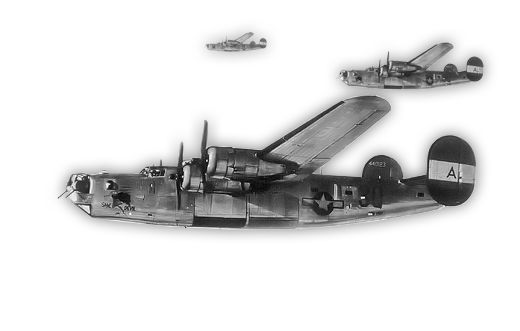Publications
Articles / Hell’s Angel of Zygodowice
Sz. Serwatka | Przegląd Lotniczy nr 5/2000
The town of Wadowice became famous as the birthplace of Pope John Paul II. The other unusual thing about Wadowice is that the local museum (Muzeum Ziemi Wadowickiej) hosts the most
professional exhibition dedicated to a US crew shot down over Poland in WW2. The exhibition is a private enterprise of Mr. Zygmunt Kraus.
Zygmunt Kraus is known local memorabilia collector. He met Commemorative Air Force (then Confederate Air Force) members during his stay in Chicago, Illinois in the 1980s. Since that time he has started to collect the memorabilia related to the American aircraft that fought on the Polish skies. The result of his activity could be seen in 1991, when a exhibition was open, dedicated mainly to the fate of a B-24 "Liberator" bomber that had crashed in a nearby village of Zygodowice. Basing on the contacts with the crew survivors and on the local witnesses accounts, Kraus was able to document the last flight of the "Hell's Angels" "Liberator" number 42-51139 of the 485th Bomb Group.
On Friday, 13th September 1944, the 15th Air Force targeted the fuel industry in Silesia. Over eight hundred aircraft, half of which were bombers, took off from Italy and took the northern heading. The 485th Bomb Group was scheduled to hit Oswiecim synthetic fuel factory. Bombs hit the target and some fell into the infamous anihilation camp of Auschwitz that was located nearby. Several prisoners and fifteen SS-men were killed. The wounded prisoners were placed in the camp hospital where usually deadly experiments were executed. But this time the wounded received flowers and were served proper food. The camp commander visited them and he was accompanied by crowds of Nazi journalists and photographers who eagerly documented the "barbarism" of the Allied air forces and the "good" treatment the prisoners received from the Nazis.
Some of the "Hell's Angels" crew had bad feelings about the mission because of the date of Friday 13th. But the call to duty and the hope to finish the combat tour soon prevailed, supported by the experience and self-confidence of the airmen. This mission was to be the end of the combat tour for the pilot, Capt. Lawrence, co-pilot Lt. Hall, navigator Lt. Winter, bombardier Lt. Pratt, radio-operator Sgt. Eggers, and the tail gunner, Sgt. Nitsche. After this one they were to get a ticket home. The other crew members on that mission were the radio navigator, Lt. Canin, lead navigator trainee, Lt. Blodgett, top turret gunner Sgt. Christensen, waist gunner Sgt. Kaplan. The oldest man in the crew was a waist gunner, Sgt. MacDonald. He was 27 years old, but some of his black hair turned white within these few months of the combat duty.
Navigator Winter remembered that the flight to target was very long - almost four hours. Around midday the formation reached the Initial Point of the bomb run and turned directly towards target on the altitude of 20000 feet. Over target the bombers flew into the flak barrage that lasted seven to eight minutes.
Christensen recalls the aircraft to have been new, silver and shining. The name was still to be painted on the nose. Christensen was in the top turret watching out for the enemy fighter planes. When he saw the cloud of the black flak bursts over target, he was sure they would be hit. He asked for a parachute but there was not enough space in the turret to snap it on. A few seconds later the aircraft received a direct hit in the right wing. Winter screamed over the intercom that the engine number 3 was out. MacDonald tried to calm down the nervous voices of the other airmen. Christensen fell down from the turret and almost lost his consciousness because he had unintentionally cut out his own oxygen supply. He has survived only because of a fellow crew member. This other airman helped Christensen to get the chute on and pushed him out of the aircraft through the open bomb bay.
The crew members from the other aircraft in the formation always had to report on the shot down aircraft so that the fate of the crew could be reported on. Sgt. Allen from another crew of the 485th Bomb Group reported that the Lawrence's B-24 was hit in the engines no. 3 and 4 and went into a spin just after "bombs away". Two chutes were seen, then the aircraft began to disintegrate, hit the ground and exploded.
Who survived and who died could be confirmed only when the surivivors were liberated at the war's end. The aged reports reveal the further part of this tragic story. Winter wrote he had bailed out together with Pratt from the nose. They decided to do so despite the lack of command to bail out, because they could not see any feet on the rudder pedals. At the same time Christensen was pushed out of the bomb bay and Canin and Blodgett followed him. Blodgett described his last moments onboard the B-24 with these words: "My position was behind the pilots. When the waist gunner informed about an engine on fire I went down into the bomb bay with the fire extinguisher. There was no alarm bell nor command on the intercom to abandon the ship. Lt. Canin was the last person to leave the bomber and he had to use all of his strength to get out because the "Liberator" went into spin at this very moment. Lawrence and Hall were seen last in the cockpit, ready to jump. Most probably, they and the airmen from the tail were trapped inside by the centrifugal force. When I opened my chute, I could not see our plane, but a trail of smoke extending towards south-east." The ship exploded over Zygodowice. Lawrence, Hall, MacDonald, Eggers, Kaplan and Nitsche died.
The eye witness of the disaster, Ferdynand Bałys of Zygodowice recalls: "It was around noon. I remember my mom saying not to go anywhere because lunch was ready. This aircraft became larger and larger and it was clear she could not maintain altitude. She was shining in the sun so uch that ooking at her was barely possible. She was banking from side to side, the engines roared loudly, as if it were a wounded beast." The aircraft trailed burning fuel. Before the B-24 hit the ground, the fuselage fell apart and witnesses saw figures of airmen falling out. The engines with propellers fell one kilometer further. The trail of smoke stayed long in the air. In the distance the chutes of the surviving Americans were descending slowly. The only civilian killed was a local girl who was badly burned by the burning fuel.
The fallen soldiers were buried near the crash site. The local citizens mared the grave with a wooden cross and a small fence. In 1947 Zygodowice were visited by the American mission searching for American graves in Poland. The remains were moved to the American Military Cementery in Begium and to the USA. Already in the wartime the grave was frequently visited by local patriotic people. After the liberation it was decided toerect a memorial dedicated to the "Hell's Angel" crew. This rememberance was not liked by the communist regime and this was probably the reason the secret police searched the houses in Zygodowice and the area. Most of the bomber's remains were confiscated and it was thought that then politically incorrect fallen allies would be soon forgotten.
The communists almost made it. The tragic story of the young Americans was forgotten for almost 50 years. The rememberance was revived thanks to Zygmunt Kraus, who organised the exhibition in Wadowice and initiated the erection of a memorial in 1991 at the crash site. Upon his invitation Vernon Chistensen, one of the "Hell's Angel" survivors, came to visit Wadowice and the memorial in 1994.
The memorabilia at the Wadowice exhibition are exceptional. Many were retrieved from the soil during the search on the crash site. Some came from the local villagers and some were donated by the "Hell's Angels" survivors. Particularly interesting is a dummy with a complete combat uniform and equipment of a USAAF airman. Another rarity is an original "Liberator" propeller. Both the dummy and propeller were donated by the American friends. Many (not only Polish) museums could be envious of them.








Photos of the exhibition in Muzeum Ziemi Wadowickiej (Museum of Wadowice County). The exhibition includes memorabilia of the American crew that was shot down on September 13th 1944 near Zygodowice. The aircraft was Consolidated B-24H "Liberator" s/n 42-51139 "Hell's Angel" of the 485th Bomb Group. The exhibition is owned by a known collecioner, Zygmunt Kraus.
(all photos via Zygmunt Kraus)
I would like to thank Zygmunt Kraus for making the source materials and photos available for making this story.
Return >>
Zygmunt Kraus is known local memorabilia collector. He met Commemorative Air Force (then Confederate Air Force) members during his stay in Chicago, Illinois in the 1980s. Since that time he has started to collect the memorabilia related to the American aircraft that fought on the Polish skies. The result of his activity could be seen in 1991, when a exhibition was open, dedicated mainly to the fate of a B-24 "Liberator" bomber that had crashed in a nearby village of Zygodowice. Basing on the contacts with the crew survivors and on the local witnesses accounts, Kraus was able to document the last flight of the "Hell's Angels" "Liberator" number 42-51139 of the 485th Bomb Group.
On Friday, 13th September 1944, the 15th Air Force targeted the fuel industry in Silesia. Over eight hundred aircraft, half of which were bombers, took off from Italy and took the northern heading. The 485th Bomb Group was scheduled to hit Oswiecim synthetic fuel factory. Bombs hit the target and some fell into the infamous anihilation camp of Auschwitz that was located nearby. Several prisoners and fifteen SS-men were killed. The wounded prisoners were placed in the camp hospital where usually deadly experiments were executed. But this time the wounded received flowers and were served proper food. The camp commander visited them and he was accompanied by crowds of Nazi journalists and photographers who eagerly documented the "barbarism" of the Allied air forces and the "good" treatment the prisoners received from the Nazis.
Some of the "Hell's Angels" crew had bad feelings about the mission because of the date of Friday 13th. But the call to duty and the hope to finish the combat tour soon prevailed, supported by the experience and self-confidence of the airmen. This mission was to be the end of the combat tour for the pilot, Capt. Lawrence, co-pilot Lt. Hall, navigator Lt. Winter, bombardier Lt. Pratt, radio-operator Sgt. Eggers, and the tail gunner, Sgt. Nitsche. After this one they were to get a ticket home. The other crew members on that mission were the radio navigator, Lt. Canin, lead navigator trainee, Lt. Blodgett, top turret gunner Sgt. Christensen, waist gunner Sgt. Kaplan. The oldest man in the crew was a waist gunner, Sgt. MacDonald. He was 27 years old, but some of his black hair turned white within these few months of the combat duty.
Navigator Winter remembered that the flight to target was very long - almost four hours. Around midday the formation reached the Initial Point of the bomb run and turned directly towards target on the altitude of 20000 feet. Over target the bombers flew into the flak barrage that lasted seven to eight minutes.
Christensen recalls the aircraft to have been new, silver and shining. The name was still to be painted on the nose. Christensen was in the top turret watching out for the enemy fighter planes. When he saw the cloud of the black flak bursts over target, he was sure they would be hit. He asked for a parachute but there was not enough space in the turret to snap it on. A few seconds later the aircraft received a direct hit in the right wing. Winter screamed over the intercom that the engine number 3 was out. MacDonald tried to calm down the nervous voices of the other airmen. Christensen fell down from the turret and almost lost his consciousness because he had unintentionally cut out his own oxygen supply. He has survived only because of a fellow crew member. This other airman helped Christensen to get the chute on and pushed him out of the aircraft through the open bomb bay.
The crew members from the other aircraft in the formation always had to report on the shot down aircraft so that the fate of the crew could be reported on. Sgt. Allen from another crew of the 485th Bomb Group reported that the Lawrence's B-24 was hit in the engines no. 3 and 4 and went into a spin just after "bombs away". Two chutes were seen, then the aircraft began to disintegrate, hit the ground and exploded.
Who survived and who died could be confirmed only when the surivivors were liberated at the war's end. The aged reports reveal the further part of this tragic story. Winter wrote he had bailed out together with Pratt from the nose. They decided to do so despite the lack of command to bail out, because they could not see any feet on the rudder pedals. At the same time Christensen was pushed out of the bomb bay and Canin and Blodgett followed him. Blodgett described his last moments onboard the B-24 with these words: "My position was behind the pilots. When the waist gunner informed about an engine on fire I went down into the bomb bay with the fire extinguisher. There was no alarm bell nor command on the intercom to abandon the ship. Lt. Canin was the last person to leave the bomber and he had to use all of his strength to get out because the "Liberator" went into spin at this very moment. Lawrence and Hall were seen last in the cockpit, ready to jump. Most probably, they and the airmen from the tail were trapped inside by the centrifugal force. When I opened my chute, I could not see our plane, but a trail of smoke extending towards south-east." The ship exploded over Zygodowice. Lawrence, Hall, MacDonald, Eggers, Kaplan and Nitsche died.
The eye witness of the disaster, Ferdynand Bałys of Zygodowice recalls: "It was around noon. I remember my mom saying not to go anywhere because lunch was ready. This aircraft became larger and larger and it was clear she could not maintain altitude. She was shining in the sun so uch that ooking at her was barely possible. She was banking from side to side, the engines roared loudly, as if it were a wounded beast." The aircraft trailed burning fuel. Before the B-24 hit the ground, the fuselage fell apart and witnesses saw figures of airmen falling out. The engines with propellers fell one kilometer further. The trail of smoke stayed long in the air. In the distance the chutes of the surviving Americans were descending slowly. The only civilian killed was a local girl who was badly burned by the burning fuel.
The fallen soldiers were buried near the crash site. The local citizens mared the grave with a wooden cross and a small fence. In 1947 Zygodowice were visited by the American mission searching for American graves in Poland. The remains were moved to the American Military Cementery in Begium and to the USA. Already in the wartime the grave was frequently visited by local patriotic people. After the liberation it was decided toerect a memorial dedicated to the "Hell's Angel" crew. This rememberance was not liked by the communist regime and this was probably the reason the secret police searched the houses in Zygodowice and the area. Most of the bomber's remains were confiscated and it was thought that then politically incorrect fallen allies would be soon forgotten.
The communists almost made it. The tragic story of the young Americans was forgotten for almost 50 years. The rememberance was revived thanks to Zygmunt Kraus, who organised the exhibition in Wadowice and initiated the erection of a memorial in 1991 at the crash site. Upon his invitation Vernon Chistensen, one of the "Hell's Angel" survivors, came to visit Wadowice and the memorial in 1994.
The memorabilia at the Wadowice exhibition are exceptional. Many were retrieved from the soil during the search on the crash site. Some came from the local villagers and some were donated by the "Hell's Angels" survivors. Particularly interesting is a dummy with a complete combat uniform and equipment of a USAAF airman. Another rarity is an original "Liberator" propeller. Both the dummy and propeller were donated by the American friends. Many (not only Polish) museums could be envious of them.








Photos of the exhibition in Muzeum Ziemi Wadowickiej (Museum of Wadowice County). The exhibition includes memorabilia of the American crew that was shot down on September 13th 1944 near Zygodowice. The aircraft was Consolidated B-24H "Liberator" s/n 42-51139 "Hell's Angel" of the 485th Bomb Group. The exhibition is owned by a known collecioner, Zygmunt Kraus.
(all photos via Zygmunt Kraus)
I would like to thank Zygmunt Kraus for making the source materials and photos available for making this story.




